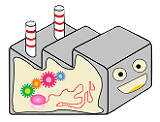Team:Gifu/Projects/Circular&RNA
From 2014.igem.org
| Line 9: | Line 9: | ||
<!--main content --> | <!--main content --> | ||
| + | <head> | ||
<table width="70%" align="center"> | <table width="70%" align="center"> | ||
| Line 40: | Line 41: | ||
| - | + | <script src="//ajax.googleapis.com/ajax/libs/jquery/2.1.1/jquery.min.js"></script> | |
| Line 53: | Line 54: | ||
<!--end navigation menu --> | <!--end navigation menu --> | ||
| - | + | </head> | |
| - | + | <body> | |
<!--Project content --> | <!--Project content --> | ||
| Line 84: | Line 85: | ||
synthesis of long-chain, massive proteins.</p> | synthesis of long-chain, massive proteins.</p> | ||
| - | <h1 style="font-family:Comic Sans MS;font-size:x-large"><a name="details">< | + | <h1 style="font-family:Comic Sans MS;font-size:x-large"><a name="details"></a>Project Detail</h1> |
<p></p> | <p></p> | ||
| - | <h1 style="font-family:Comic Sans MS;font-size:x-large"><a name="progress">< | + | <h1 style="font-family:Comic Sans MS;font-size:x-large"><a name="progress"></a>Progress</font></h1> |
<p></p> | <p></p> | ||
| - | <h1 style="font-family:Comic Sans MS;font-size:x-large"><a name="M&M">< | + | <h1 style="font-family:Comic Sans MS;font-size:x-large"><a name="M&M"></a>Materials and Methods</h1> |
<p></p> | <p></p> | ||
<h1 style="font-family:Comic Sans MS;font-size:x-large"><a name="experiments"><font color="black">The Experiments</font></a></h1> | <h1 style="font-family:Comic Sans MS;font-size:x-large"><a name="experiments"><font color="black">The Experiments</font></a></h1> | ||
Revision as of 02:32, 3 September 2014




 "
"